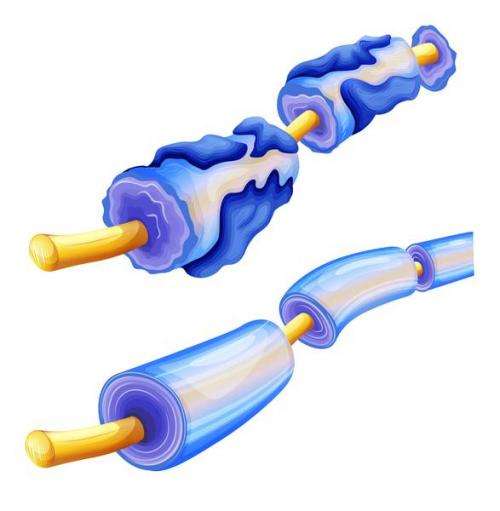Neutron diffraction shows how myelin gets on your nerves

New research has shed light on the way in which our nerves conduct electrical signals around our bodies. The structure of myelin, the layer of insulating fat surrounding nerve cells of vertebrates, has now been analysed in detail using neutron diffraction, providing a major step forward in understanding how our body's nervous system functions. Defects in myelin structure are known to significantly impair nerve conduction, and are implicated in such incompletely understood neurological disorders as multiple sclerosis and Charcot-Marie-Tooth disease in the Central Nervous System (CNS) or Guillain-Barré Syndrome and Chronic Inflammatory Demyelinating Polyneuropathy in the Peripheral Nervous System (PNS). It is hoped that an improved understanding of the structure and functionality of myelin will enhance our ability to detect and treat these conditions in future.
In research published this week in Acta Crystallographica D, the structure and flow of water through rodent myelin has been analysed thanks to data collected at the Institut Laue Langevin (ILL) in Grenoble, the world's leading neutron source.
Prof Daniel Kirschner together with graduate student Andrew Denninger (both of Boston College, Chestnut Hill, Massachusetts) and their team performed the measurements with solutions containing mixtures of light water (H2O) and so-called heavy water (D2O), formed using a heavier isotope of hydrogen known as deuterium. By comparing the way these two species flow through the membrane, the researchers were able to see how fast water diffuses within the myelin sheath. Knowing this is contributing to our understanding of how rapidly ions and other solutes including metabolites and toxins may traverse the membranes and affect signal propagation. Myelin acts as electrical insulation for the underlying nerve axon. The speed of water flow is a measure of how electrically "tight" the myelin is.
These experiments, the first of their kind in 45 years, revealed new structural details for myelin in the central nervous system (those nerve cells within the brain and spinal cord) as well as in the peripheral nervous system. Exchange in PNS was found to be almost twice as fast as in the CNS and differences in exchange behaviour between the PNS and the CNS myelin were observed suggesting different routes of diffusion and perhaps different vulnerabilities.
In addition to accurately locating the presence of aqueous spaces within the myelin, the researchers were also able to locate asymmetries within membranes; these may be related to how myelin is normally stabilized against disruption.
In the past, myelin has typically been investigated using light and electron microscopy as well as X-ray diffraction. Although each technique has its advantages, none is sufficient in itself for complete structural determination. The fact that neutrons are scattered by atomic nuclei rather than electrons makes them well-suited for detecting different isotopes of the same element, which means that neutron diffraction can allow for the determination of myelin structure with very high accuracy using H2O-D2O exchange and can be used to determine the localization of molecules within myelin.
Bruno Demé, instrument leader at the ILL and one of the authors on the study, said: "Neutron diffraction of the sort undertaken at ILL is ideal for determining the structure of a natural membrane such as myelin. The dense packing of layers within each sample makes the nervous system a good target for diffraction, and demonstrates the potential for further neutron diffraction studies on pathological forms of myelin."
While a full understanding of the origins, architecture and dynamics of myelin depends on microscopic analysis as well as diffraction, the study demonstrates how much is possible with neutron diffraction techniques on their own.
More information: "Neutron scattering from myelin revisited: bilayer asymmetry and water-exchange kinetics." Acta Crystallographica D, 70: 3198–3211. doi: 10.1107/S1399004714023815
Provided by Institut Laue-Langevin


















